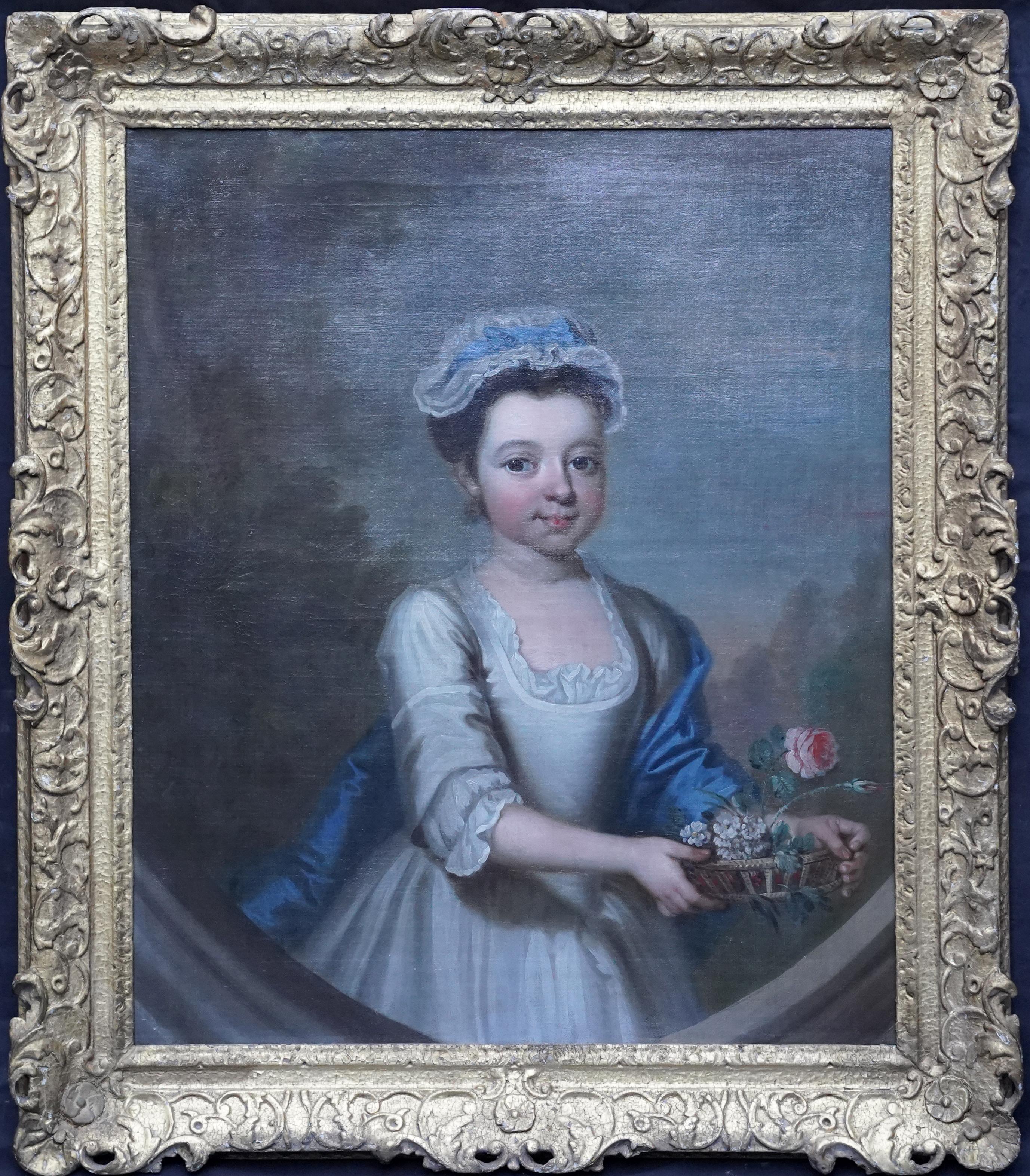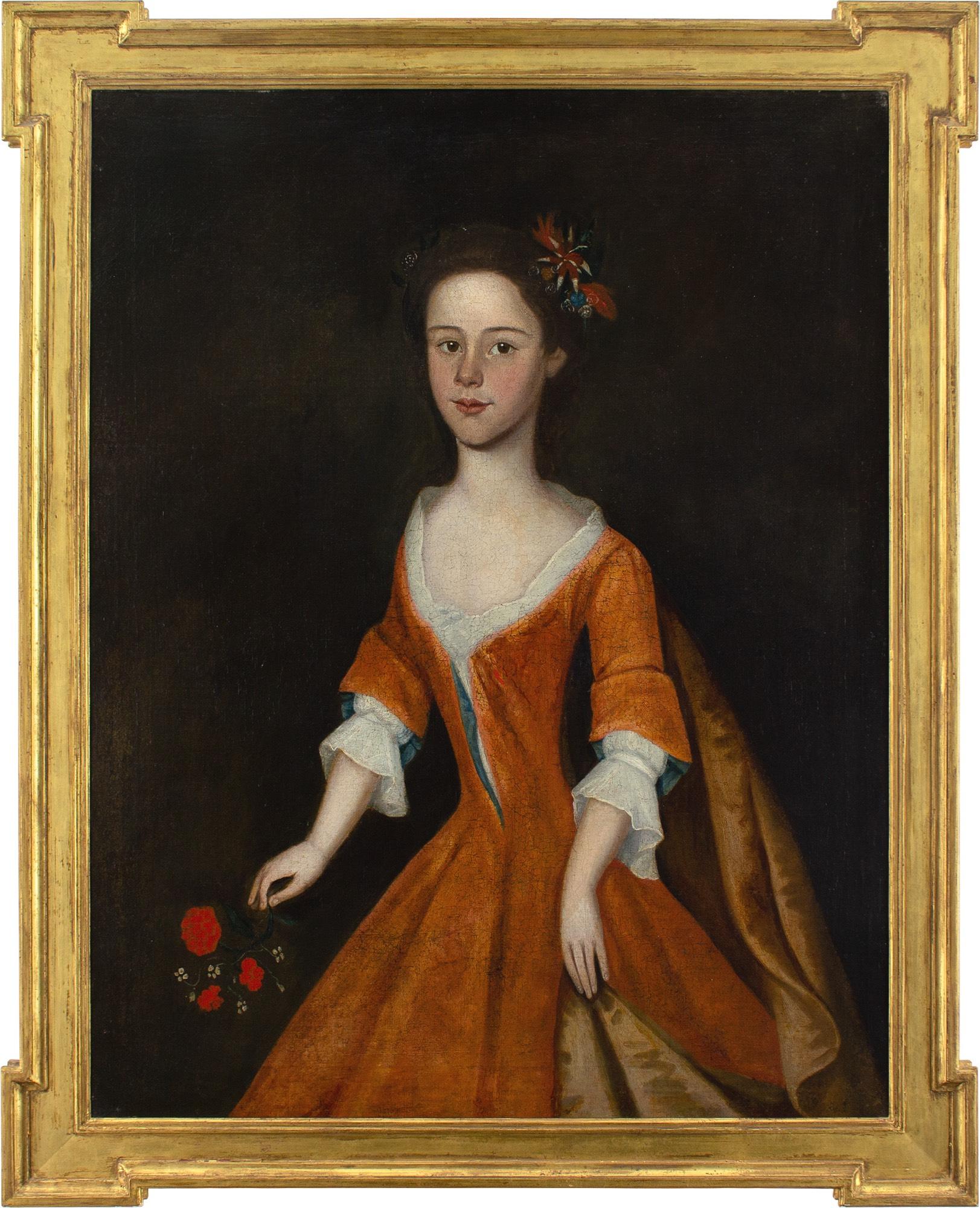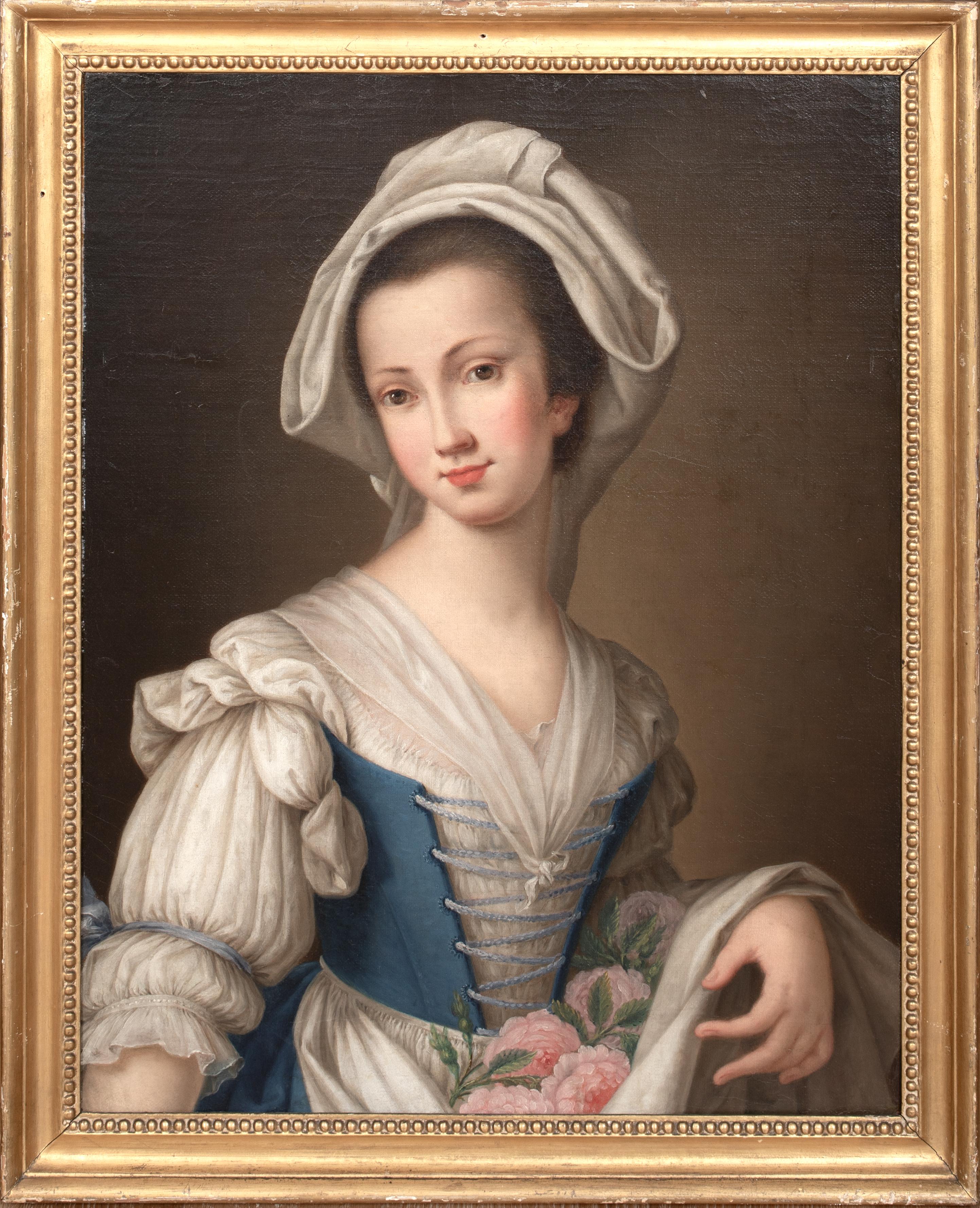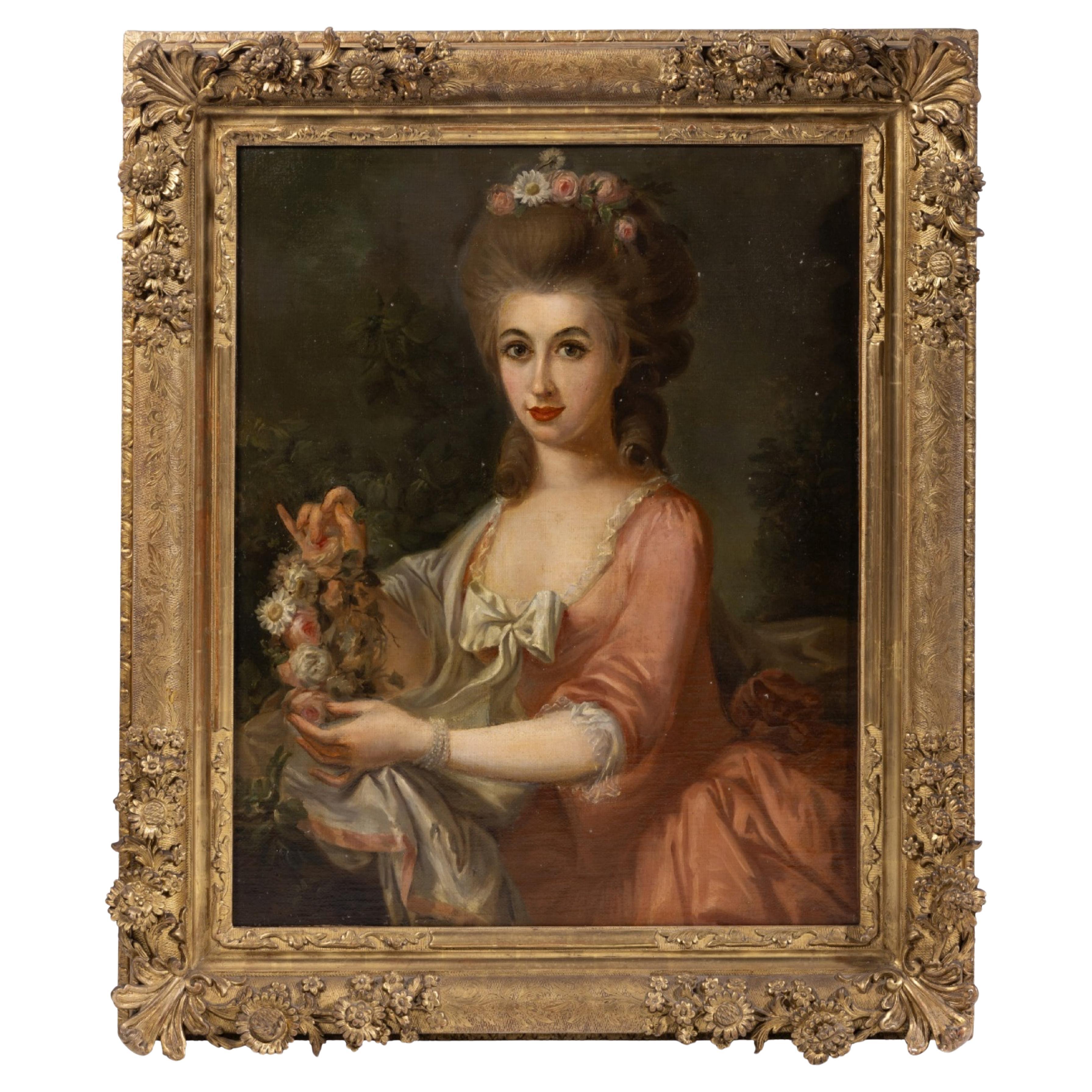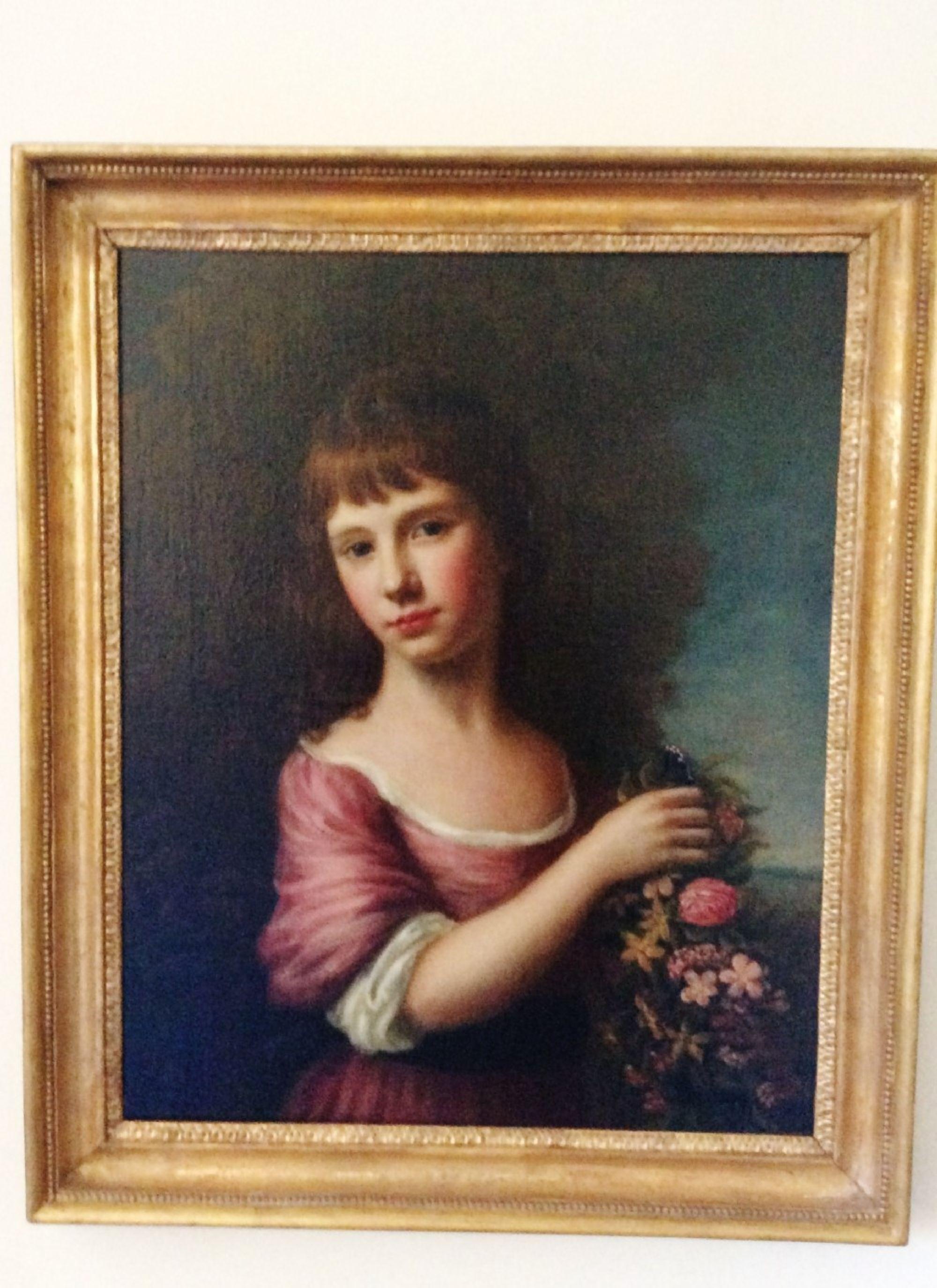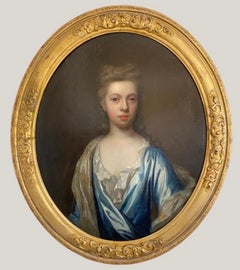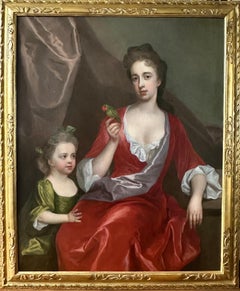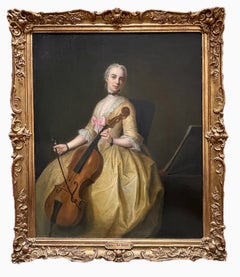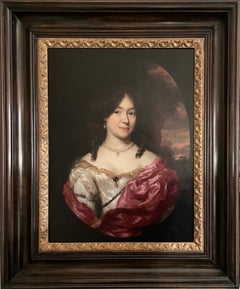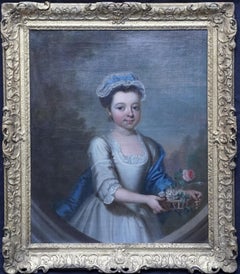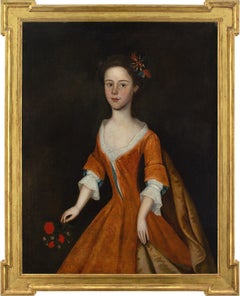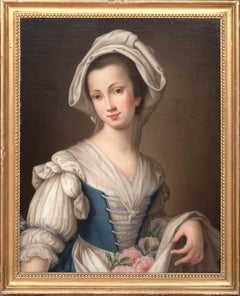Items Similar to 18th century English portrait of a lady beside an urn, with a basket of flowers
Video Loading
Want more images or videos?
Request additional images or videos from the seller
1 of 13
Tilly Kettle18th century English portrait of a lady beside an urn, with a basket of flowersc. 1765
c. 1765
$24,701.59
£18,000
€21,164.22
CA$34,106.10
A$37,821.15
CHF 19,872.21
MX$462,110.13
NOK 248,628.42
SEK 233,380.25
DKK 157,995.07
About the Item
Portrait of a lady wearing a white gown with a red cloak, pearls in her hair and draped over one shoullder, standing beside a classical urn with a basket of flowers, c.1765.
The portrait is believed to be a companion portrait of a John (1741-1816) or James (1751-1807) Durno which is housed in an identical frame. The sitter is possibly either the wife of John who was Janes Byres of Stonywood or John and James's sister Elizabeth. (James never married). The Durno family were based around the Aberdeen area of Scotland and John was an advocate in the area and then later a customs official in Jamaica. James was a successful timber merchant, spending time in the Baltic before being made His Majesty's Consul in Memel, Prussia.
The portrait is likely to have been painted before Tilly travelled to India in 1768, when John, Jane and Elizabeth would have been in their twenties.
We are gtrateful to Mark Beattie for sharing his family knowlege and research on the portrait.
Provenance:
With W. C. Beattie in the mid 19th century, and by descent through the family
Private collection, Kent
With thanks to Hugh Belsey who has confirmed this to be the work of Tilly Kettle from photographs.
Tilly Kettle (1735-1786) was born in London, the third of six children by Henry Kettle (c.1704-c.1773), a coach painter, and his wife Ann. He attended William Shipley's drawing school in the Strand and from there he may have progressed to the St Martin's Lane Academy and the Duke of Richmond's sculpture gallery. During the early 1750's he was introduced to Joshua Reynolds whom he admired and who greatly influenced his portrait style.
He first exhibited at the Free Society of Artists in 1761 and between 1762 until around 1764 he undertook various commissions between Oxford, the Midlands and London. These included the principal of Brasenose College, Oxford, Dr Francis Yarborough, the poet Anna Seward (National Portrait Gallery, London) as well as numerous portraits of the Legge family, commissioned by the second Earl of Dartmouth. He continued to exhibit with the Society of Artists up to 1776, when he then began exhibiting with the Royal Academy.
In 1768. he was granted permission by the East India Company to travel to Bengal, India, to work as as artist, becoming the first professional artist to make a career there. Arriving in Madras, among his first commissions was a portrait of Lord Pigot, the former Governor of Madras and his clientele consisted of nabobs, merchants and army officers. He also painted a group portrait of Muhammed Ali Khan, nawab of Arcot , with his five sons, which Kettle exhibited at the Society of Artists in 1771, as well as a full-length portrait of Muhammed. (Victoria and Albert Museum, London).
By late 1771, kettle was in Calcutta where he painted a large double portrait of Charles and John Sealy (Courtauld, London) and Warren Hastings, whom Kettle painted at least three times. Whilst in Calcutta, he took an Indian 'bibi' or mistress, and had two daughters, Ann and Elizabeth.
In 1776 he returned to England and married Mary, the younger daughter of the architect James Paine and he had two further children Mary and a son John. He began exhibiting at the Royal Academy, showing works there until 1783.
The marriage was not a success and with increasing financial difficulties, in 1786 Kettle decided to return to India, reaching as far as Aleppo where he painted what might have been his last portrait of 'The Turkish Janissary of the English Factory (private collection). He is thought to have died shortly afterwards before the end of 1786 from unknown circumstances.
Literature: James D. Milner, Tilly Kettle, The Walpole Society volume fifteen, 1927, page 47
- Creator:Tilly Kettle (1735 - 1786, English)
- Creation Year:c. 1765
- Dimensions:Height: 38.98 in (99 cm)Width: 31.89 in (81 cm)
- Medium:
- Movement & Style:
- Period:
- Condition:
- Gallery Location:Bath, GB
- Reference Number:1stDibs: LU9528862762
About the Seller
5.0
Vetted Professional Seller
Every seller passes strict standards for authenticity and reliability
Established in 2002
1stDibs seller since 2015
37 sales on 1stDibs
Associations
The British Antique Dealers' AssociationLAPADA - The Association of Arts & Antiques DealersInternational Confederation of Art and Antique Dealers' Associations
- ShippingRetrieving quote...Shipping from: Bath, United Kingdom
- Return Policy
Authenticity Guarantee
In the unlikely event there’s an issue with an item’s authenticity, contact us within 1 year for a full refund. DetailsMoney-Back Guarantee
If your item is not as described, is damaged in transit, or does not arrive, contact us within 7 days for a full refund. Details24-Hour Cancellation
You have a 24-hour grace period in which to reconsider your purchase, with no questions asked.Vetted Professional Sellers
Our world-class sellers must adhere to strict standards for service and quality, maintaining the integrity of our listings.Price-Match Guarantee
If you find that a seller listed the same item for a lower price elsewhere, we’ll match it.Trusted Global Delivery
Our best-in-class carrier network provides specialized shipping options worldwide, including custom delivery.More From This Seller
View AllEnglish 18th century portrait of a lady, Circle of Thomas Murray (1663-1735)
Located in Bath, Somerset
An early 18th century portrait of a young lady, half length, wearing a blue silk gown with white chemise and gold trimmed cloak draped across her arm and shoulders. Her sensitively observed soft expression and skilfully painted youthful 'dewy' complexion are reminiscent of the portrait style of John Closterman whose work Murray would have been familiar with, being a close colleague of Murray's teacher, John Riley.
An old label on the reverse identifies the sitter as a young Princess Charlotte...
Category
Early 18th Century Old Masters Portrait Paintings
Materials
Canvas, Oil
$8,233 Sale Price
20% Off
A portrait of a lady and her daughter with an exotic bird
By Michael Dahl
Located in Bath, Somerset
A portrait of a lady three-quarter length, seated in an interior, wearing a red silk gown draped in a pink silk sash with an exotic bird perched on her hand and one arm resting on a stone plinth, her young daughter wearing a green silk gown standing at her side.
Oil on canvas, housed in a period 'Lely' giltwood frame.
This double portrait was painted at the height of Dahl's career in circa 1715 when Dahl had become firmly established as one of the leading portrait painters in Britain. Although the identities of the sitters are currently unknown, it is a sensitive depiction of a close and affectionate bond between a mother and daughter, with the young girl's hand resting affectionately on her mothers lap. The tamed exotic bird adds a charming decorative element which also serves to convey the high social status of the lady, given only the very wealthy would be able to own such a rare and expensive pet and the lively colouring of the bird's feathers is reflected in the colours of the sitters' silk gowns.
Provenance: Private collection, London
Michael Dahl (Stockholm 1659-1743 London) was born in Stockholm in Sweden and studied under Martin Hannibal (d 1741) and later with David Klöcker Ehrenstrahl. In 1682 he travelled to London, where he became acquainted with Godfrey Kneller and Henry Tilson, and in 1685 he left for Europe with Tilson, working briefly in Paris before continuing to Venice and Rome, where they stayed for about two years. In Rome Dahl converted to Roman Catholicism and gravitated towards the circle of Christina, former Queen of Sweden, who sat for him (Grimsthorpe Castle, Lincs). He returned to England with Tilson via Frankfurt and arrived in London in 1689, staying in England for the remainder of his career.
During Dahl's absence, Kneller had consolidated his supremacy in London as the most fashionable portrait painter, but Dahl rapidly became Kneller’s closest competitor. His patrons probably had roots in the Swedish diplomatic circles, but it expanded as a result of his ability and his agreeable personality. His prices were lower than those of Kneller and he favoured softer, more diffused, colour tones and could respond to his sitters with sincerity and humanity. Politically, Kneller supported the ascendant Whigs while Dahl was a Tory, but they frequently painted the same sitters from both parties, and in spite of fundamental differences in technique and temperament, their work was sometimes similar in appearance.
Dahl was prolific but rarely signed his work, and comparatively few of his portraits were engraved in mezzotint, the method used by Kneller to widen his reputation. By 1690 he had painted the aged Duke of Schomberg (engraved by William Faithorne) and Prince George of Denmark (London, Kensington Palace). He was ignored by William III but received commissions from Princess Anne, including one for a portrait of herself (Oakly Park, Ludlow, Salop). He also painted the future Duke and Duchess of Marlborough, and his informal portrait of the Duchess (Althorp House, Northants), formerly attributed to Kneller, is perhaps the most intimate of all images of her.
During the 1690s he secured the patronage of Charles Seymour, the ‘Proud’ 6th Duke of Somerset, who ordered a series of seven full-length portraits of notable contemporary beauties from Dahl (1690s; Petworth House, W. Sussex, NT). This was originally a scheme similar to Kneller’s more famous ‘Hampton Court Beauties’, but the portraits were subsequently reduced to three-quarter-length formats. The features of the sitters are not individualized, but they possess a decorative, languorous glamour that recalls Lely rather than Kneller. Somerset gave Dahl further employment over the next 25 years.
In 1698, following the death of Klöcker Ehrenstrahl, Dahl was offered the post of court painter at Stockholm, which he apparently refused, preferring to remain in London at his studio in Leicester Fields, near the Swedish legation. In about 1700 he was joined by a young compatriot, Hans Hysing, who worked with him for many years. Dahl seems not to have married until after 1708, He had a son Michael (d. 1741), also a painter, of whose work nothing is known, and two daughters.
After the accession of Queen Anne in 1701, she and Prince George sat for a number of official portraits. His royal patronage ceased with Queen Anne’s death, and when Dahl refused to paint the infant Duke of Cumberland in 1722. He was suspected of Jacobite sympathies, and relations had cooled between him and the Swedish legation. However, his practice continued to prosper, and he acquired another important patron in Edward Harley, 2nd Earl of Oxford, who shared his political views and whose circle included the architect James Gibbs and the poets Matthew Prior and Alexander Pope, all of whom Dahl painted. Oxford commissioned several portraits of himself. In the earliest (1719; Welbeck Abbey...
Category
Early 18th Century Old Masters Portrait Paintings
Materials
Canvas, Oil
$26,348 Sale Price
20% Off
18th century portrait of the artist’s daughter, Catharina, playing the cello
By Balthasar Denner
Located in Bath, Somerset
The sitter, seated in a yellow silk gown trimmed with a pink bow playing the cello, is believed to be the artist Balthazar Denner's eldest daughter Catharina (1715-1744), after his marriage to Esther Winter in Hamburg in 1712. She is also recognisable in another portrait of the Denner family in the Hamburg Kunsthalle, painted circa 1740 by the artist's son, Jacob Denner (1722-1765). Oil on canvas in a period giltwood frame.
Provenance: Private collection, Northern Germany
Professor Helmut Borsch-Supan, Berlin, confirmed the authenticity of the painting after examining it in 2013. The painting will also be included in the forthcoming catalogue raisonnée of the artist, by Ute Mannhardt.
Balthasar Denner...
Category
Early 18th Century Old Masters Portrait Paintings
Materials
Canvas, Oil
17th century portrait of a lady
By Nicolaes Maes
Located in Bath, Somerset
Portrait of a lady by Dutch Golden Age painter Nicolaes Maes (1634-1693). Half-length, within a feigned oval, the lady wears a pearl necklace and earrings, an ivory silk gown adorned...
Category
17th Century Old Masters Portrait Paintings
Materials
Canvas, Oil
17th century portrait of lady in an ivory silk gown and lace collar
By Cornelius Johnson
Located in Bath, Somerset
Circle of Cornelius Johnson (1593-1661), a 17th century portrait of a lady, bust-length oval, wearing an ivory silk gown with blue silk bows and lace c...
Category
Early 17th Century Old Masters Portrait Paintings
Materials
Canvas, Oil
$16,467 Sale Price
25% Off
English 18th century portrait of a Lady and her Daughter in an interior
By (attributed to) Joseph Highmore
Located in Bath, Somerset
Portrait of a lady, three-quarter length, wearing a blue silk gown, seated in a classical interior, with her daughter in a pink gown standing beside her holding a sprig of blossom. T...
Category
Early 18th Century Old Masters Portrait Paintings
Materials
Oil
You May Also Like
Portrait of a Girl with Basket of Flowers -British 18thC Old Master oil painting
Located in Hagley, England
This charming 18th century Old Master cartouche portrait oil painting is attributed to the circle of Philip Mercier. Painted circa 1740 the composition is a three quarter length portrait of a young girl holding a wicker basket of flowers. She is clothed in a white dress and beautiful blue silk shawl and is situated in a landscape. A very lovely British Old Master portrait oil painting.
Provenance. Christies.
Condition. Oil on canvas, 30 inches by 25 inches and in good condition.
Frame. Housed in an ornate gilt carved 18th century frame, 38 inches by 33 inches and in good condition.
Philippe Mercier (also known as Philip Mercier; 1689-1760) was a French painter and etcher, who lived principally and was active in England. He was born in Berlin of French extraction, the son of a Huguenot tapestry-worker. He studied painting at the Akademie der Wissenschaften of Berlin and later under Antoine Pesne, who had arrived in Berlin in 1710. Later, he travelled in Italy and France before arriving in London—"recommended by the Court at Hannover"—probably in 1716. He married in London in 1719 and lived in Leicester Fields. He was appointed principal painter and librarian to the Prince and Princess of Wales at their independent establishment in Leicester Fields, and while he was in favour he painted various portraits of...
Category
18th Century Old Masters Portrait Paintings
Materials
Oil
Portrait of Lady with Garland of Flowers - British 17thC Old Master oil painting
By Michael Dahl
Located in Hagley, England
This charming 17th century Old Master portrait oil painting is attributed to the circle of Swedish born Michael Dahl who lived and work in England for most of his life. Painted circa...
Category
17th Century Old Masters Portrait Paintings
Materials
Oil
Mid-18th-Century English School, Portrait Of A Girl With A Posy
Located in Cheltenham, GB
This exceedingly charming mid-18th-century English oil painting depicts a girl wearing a red gown with a train over a white petticoat. She’s holding a posy or nosegay.
Evidently once commissioned for an English country house, the identity of this young lady remains a mystery. Her gown appears to be inspired by the popular ‘robe à la française...
Category
1740s English School Portrait Paintings
Materials
Oil, Canvas
Maid Carrying Roses, 18th Century
Located in Blackwater, GB
Maid Carrying Roses, 18th Century
circle of Antonio ROTARI (1707-1762)
Large 18th Century Italian portrait of a young maid carrying ros...
Category
18th Century Portrait Paintings
Materials
Canvas, Oil
$6,038 Sale Price
20% Off
FRENCH SCHOOL "Portrait of a Girl with Flowers". 18th Century
Located in Madrid, ES
FRENCH SCHOOL
"Portrait of a Girl with Flowers".
Oil on canvas from the 18th century.
Relined.
Dimensions: 80 x 64 cm
Good condition
Category
Antique 18th Century French Baroque Paintings
Materials
Paint
Nathaniel Hone, portrait of "flora" roman goddess, 18th century
By Nathaniel Hone the Elder
Located in York, GB
I have great pleasure in offering for sale this beautiful portrait, by Nathaniel Hone, the elder. 18th century. The painting is of Ann Anderson, wife...
Category
18th Century Old Masters Portrait Paintings
Materials
Oil
More Ways To Browse
18th Century English Painting
18th 19th Century Portraits
18th Century English Portrait
18th Century Flower Paintings
Basket Flower Painting
18th Century Scotland
19th Century Painting India
Draped Urn
19th Century Indian Painting
Indian Art 18th
19th Century Turkish Paintings
India Painting 18th Century
William And Mary Antiques
Five Strand Pearls
Henry William Standing
18th Century Indian Painting
Annas Antiques
India Urn
